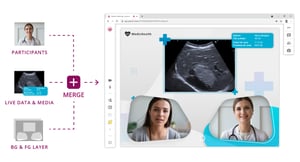
The Impact of Video in the Digital Healthcare Sector
Right now, 76% of U.S. hospitals are employing video technology to meet with patients and consultants. This represents a sharp rise in video applications and an impactful change in the digital healthcare sector.
Video is changing how doctors, nurses, patients, and consultants interact and engage in medical treatments. With enhanced accessibility through video conferencing, millions are receiving the care they need from the comfort of their own homes.
But the impact of video in the digital healthcare sector may go even further. Here, you can explore the rise of video as a healthcare tool and its effect on the industry.
Long before the COVID-19 pandemic emerged, video had been implemented into virtual healthcare procedures collectively known as telehealth. However, it took the pandemic to kick off the application of this tool as a popular resource.
Research from the Office of Health Policy found that the use of telehealth jumped from less than 1% from the beginning peaks of the pandemic to as high as 80% later in 2020. In the same timeframe, Medicare telehealth utilization increased 63 times over.
Why the sudden rise? Simply put, video makes healthcare simple and convenient. We live in a world in which an estimated 6.64 billion people (that’s 83.72% of the world’s population) own and use smartphones. Many of these come equipped with increasingly powerful cameras. From here, it’s just a matter of setting up a telehealth service with a care provider.
Video has become a staple of healthcare services in the modern era because of its convenience and quality. In fact, 93% of surveyed patients found that telehealth adequately addressed their concerns because it enables primary care services like the following:
- Follow-up visits
- Ongoing condition monitoring
- Quick check-ins
- Diagnosis
- Treatment advice for minor injuries
While there are still a lot of medical solutions that cannot be completed over video, the use cases for video in healthcare are increasing all the time. Low bandwidth conferencing platforms even make telehealth possible in more rural areas where internet access is limited.
The impact of video as a healthcare tool is overwhelmingly positive. That’s because video offers a host of benefits that assist both medical teams and their patients in staying safe and preventing burnout.
The Benefits of Video in Healthcare
With the rise in video in healthcare has come a realization among care professionals that their workflows, as well as patient solutions, can be streamlined through this technology. The applications of telehealth services are diverse. So are the benefits that come from integrating them.
From the operational gains to the life-saving potential of video healthcare, telehealth services are changing the ways we think about medical care on the whole. These are just a few of the important benefits impacting the digital healthcare sector:
Convenience and Comfort
First and foremost, the role of video in healthcare has created an environment in which healthcare is more convenient and comfortable than ever before. For many reasons, patients can experience difficulties when it comes to seeking out medical care. For instance, individuals suffering from medical anxiety or PTSD symptoms like recurring nightmares might find the experience of physically going to the doctor triggering. Telehealth presents an opportunity for these patients to have a better, more comfortable experience.
Easier Recoveries
Similarly, patients recovering from extensive procedures and who require bed rest are much better served by virtual check-ins. Through video conferencing, care providers can monitor these recovering patients without having to disrupt their rest. The implementation of telehealth in post-operative care has been found to reduce hospital readmissions while improving patient satisfaction.
Reduced Costs and Materials
One study found that the use of in-home care tools like video to treat seniors who refused to be seen in hospitals cost 32% less than traditional hospital visits. This demonstrates how video can help serve to cut costs through a reduction in supplies, travel expenses, time and labor, and more. Since patients don’t have to leave their homes to speak with a doctor over video, savings are passed on to them. Facing high gas prices, this makes video healthcare more convenient than ever.
Reduced Burnout
Telehealth has also assisted care providers in managing their workload. With the ability to adjust a schedule to a hybrid model in which patients can be seen from a home office, these professionals can arrange for a more flexible work-life balance. Additionally, video allows health professionals to display real-time data to patients in ways that might be difficult in-office. As a result, telehealth can create a more accessible and transparent care environment for everyone.
Greater Accessibility and Safety
Finally, video offers enhanced safety and accessibility for many of the most at-risk and underserved patients. For example, approximately 10 million people in the U.S. alone live with an autoimmune disease. These patients put themselves at risk going to follow-up appointments and in-office check-ups. Video conferencing offers a safe and accessible solution for the millions with sufficient internet access. With advances in low bandwidth technology, even patients in more rural areas are finding this care accessible and valuable.
These many benefits of video technology are enhancing the digital healthcare sector for the good of patients all over the world. As a result, the cumulative impact of this technology is a positive one. Care providers can implement video to assist in these virtual procedures, from check-ins to diagnosis.
Elevating Digital Healthcare with Video
The inclusion of video in the toolkit of healthcare professionals is leading to all kinds of positive implications. Now, even eSignatures are more secure and personal with the help of video collaboration. The digital healthcare sector will continue to embrace this technology due to its popularity and value.Consider the impact of video in healthcare, then explore how this technology can serve you in your own care or medical practice. These benefits and more await.